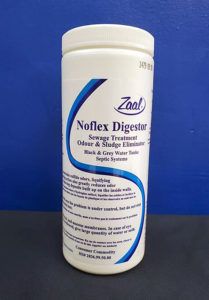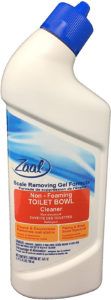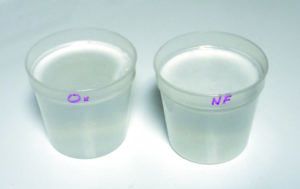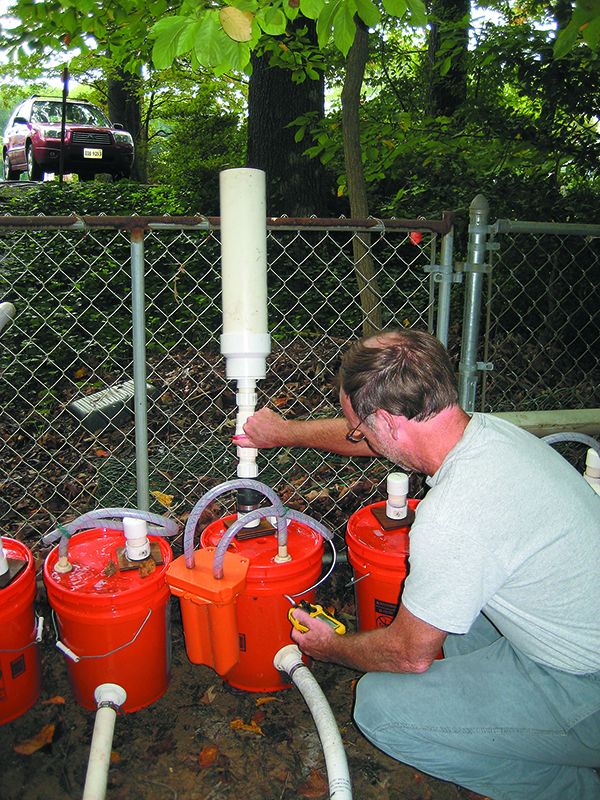Sodium percarbonate (Na2H3CO6 ) is a hydrate formed between sodium carbonate and hydrogen peroxide, and is more properly written 2 Na2CO3 + 3 H2O2 . When mixed with water it dissociates into sodium ions, carbonate ions, and hydrogen peroxide, which subsequently decomposes into oxygen and water through a series of intermediate steps.
At concentrations above about 1-2%, hydrogen peroxide is a disinfectant; however, at low concentrations, such as diluted in a holding tank, hydrogen peroxide is actually beneficial to bacteria. It is quickly decomposed into hydrogen and oxygen by catalase, an enzyme present in all living organisms, and thus provides a rich source of oxygen. Peroxide is sometimes intentionally added as a supplemental form of oxygen during biological treatment of strong industrial wastewater.
If percarbonate is actually beneficial to the holding tank biome, this raises several interesting questions. Readers had asked if OxiClean, which is primarily percarbonate, is a safe toilet cleaner. Probably. And by extension, since Noflex (see “Stopping Holding-tank Odors, Part II,” PS December 2012) is basically OxiClean with a few surfactants added, will it make a good toilet cleaner? Can OxiClean work as a holding tank treatment? Probably.
What We Tested

We tested OxiClean, Zaal Noflex Digester, and Zaal Toilet Bowl Cleaner, using the top-rated product from our last cleaner review, Starbrite Toilet Cleaner, as a control reference. See “Clean Potty Overkill,” PS November 2019 for a full review of toilet bowl cleaners and “Stopping Holding Tank Odors Part II,” PS December 2012 for a review of holding tank treatments.
How We Tested
We waited patiently for toilets to become soiled, applied each product according to the instructions, and visually graded the results. We also tested OxiClean as a holding tank treatment, following the rough protocol laid out in “Solutions for a Stinky Holding Tank” (PS, February 2012) for holding tank treatments, using Camco Ultra Citrus and Zaal Noflex as a control references. Finally, we soaked joker valves in each product at four times the normal concentration for three months, changing the solution weekly, to check for damage.
Observations
Because percarbonate decomposes when mixed with water, it must be stored as a powder and cannot be made up ahead of time. OxiClean and Noflex powders must be mixed up only when you are ready to use them.
Both OxiClean and Noflex effervesce when mixed with water. The percarbonate releases hydrogen peroxide, which releases oxygen gas over time. In a holding tank, however, nearly all of the gas will dissolve in the water and be immediately consumed by bacteria. We do not believe, as some have suggested, that this increases the risk of over pressuring the holding tank, since holding tanks generate gas (methane) when there is not enough oxygen, and the effects are offsetting. Obviously, the holding tank vent must be kept clear at all times to prevent problems with pumping the head, pumping out, and over pressurization or collapse. Rinsing the vent at each pump-out is recommended.
Toilet bowl Cleaners
As a cleaner, OxiClean is effective in removing organic stains. Put a few tablespoons in the bowl, mix to dissolve, and then splash around, with special focus under the rim. Close the lid to reduce evaporation and let it sit for 30 minutes. Give it a quick scrub and flush. It is very effective at removing organic materials and stains, but not effective on scale (because it is not acid). On the other hand, since it is actually beneficial as a holding tank treatment, it can be used frequently without harm. See more product test results in “Clean Potty Overkill,” Practical Sailor, November 2019.

As a corollary, we found No-Flex is an equally effective toilet bowl cleaner. Same basic ingredients, no surprise.
Zaal Toilet Bowl Cleaner takes a different approach, using sulfamic acid in combination with surfactants. This combination is well known in industry for descale and did a serviceable job, though it is known to be aggressive to some metals and is a strong acid, like hydrochloric or sulfuric.
Holding tank treatment

As a holding tank treatment, OxiClean is moderately effective, on a par with Zaal Noflex, which we recommended in “Stopping Hold Tank Odors Part II.” Both are based on percarbonate, function in the same way, and give similar results. Compared to nitrate treatments, they are faster acting, but require more frequent application; instead of every 3-5 days, smaller amounts every 1-2 days work better. However, we are not recommending OxiClean as a holding tank treatment at this time, solely because of lack of extended experience.
Percarbonate (Noflex, OxiClean) and nitrate based (Camco Ultra, Forespar Refresh, Odorlos, Raritan CP) treatments can be combined without negative interaction. They work in similar ways and do not interfere with each other. We’re not suggesting mixing them, only that products within these groups live well together.
Products that combine enzymes and live culture (Raritan KO) should also be harmless. Avoid holding tank treatments or cleaning products containing antiseptic ingredients, including formaldehyde, bronopol, bleach, or quaternary amines.
Although none of the products seriously damaged or affected the flexibility or sealing characteristics of the joker valves, we did notice a slight change in surface texture. The valves soaked in Noflex and OxiClean were noticeably duller and had a slightly higher friction feel than those soaked in Camco Ultra or tap water. We still consider both OxiClean and Noflex safe for most holding tank materials. Because both urine and sodium percarbonate are corrosive towards aluminum, we never recommend aluminum holding tanks.
Conclusions

Readers asked if they could safely use OxiClean to clean the toilet bowl. The answer is yes, but it is less effective on lime deposits than other PS recommended cleaners. Although percarbonate-containing treatments such as Noflex work as a holding tank treatment, we’re standing by our original recommendations for Camco Ultra, Forespar Refresh, Odorlos, and Raritan CP; they work longer and may be less damaging to elastomeric parts.
OXICLEAN, www.oxiclean.com
ZAAL NO-FLEX,www.gemini-ltd.com
CAMCO, www.camco.net
FORESPAR, www.forespar.com
ODORLOS, www.odorlos.com
RARITAN, www.raritaneng.com
RID-X, www.rid-x.com
THETFORD, www.thetford.com








































